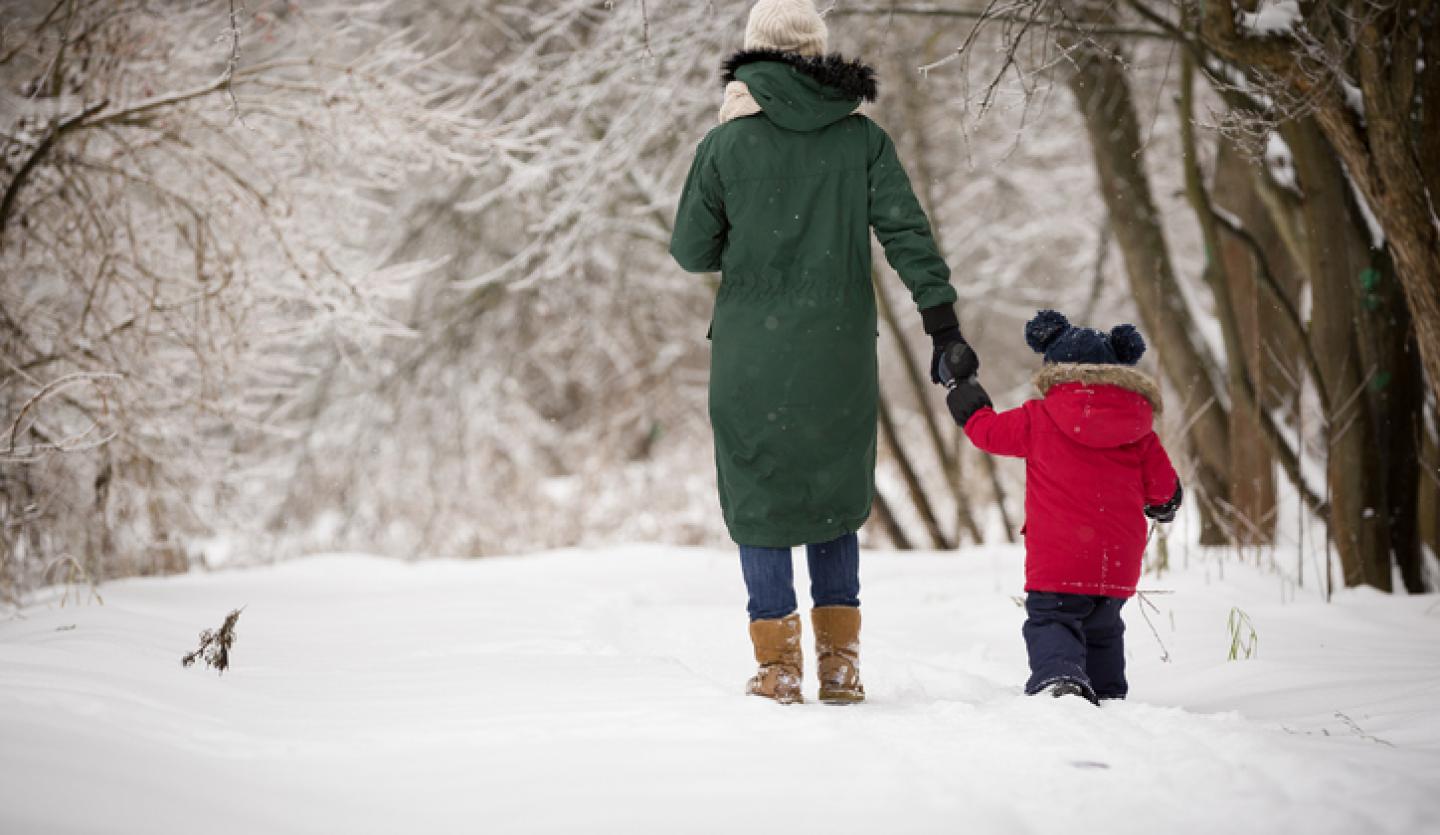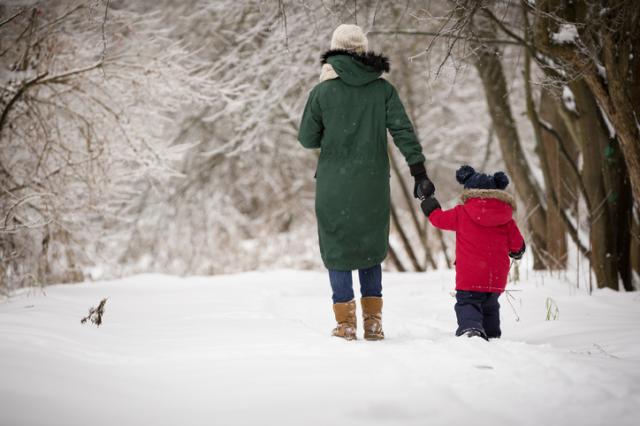Winter brings with it visions of snowmen, sledding, hot coco and snuggling by the fire. These tips from the American Academy of Pediatrics (AAP) and National Institutes of Health can help you keep your family safe and warm.
What to Wear
- Dress infants and children warmly for outdoor activities. Several thin layers will keep them dry and warm. Don’t forget warm boots, mittens and a hat.
- Dress older babies and young children in one more layer of clothing than an adult would wear in the same conditions. Remove wet clothes immediately.
- When riding in the car, babies and children should wear thin, snug layers rather than thick, bulky coats or snowsuits.
- Blankets, quilts, pillows, bumpers, sheepskins and other loose bedding should be kept out of an infant's sleeping environment because they are associated with suffocation deaths and may contribute to Sudden Infant Death Syndrome (SIDS). It is better to use sleep clothing like one-piece sleepers or wearable blankets.
- If a blanket must be used to keep a sleeping infant warm, it should be thin and tucked under the crib mattress—reaching only as far as the baby’s chest so the infant's face is less likely to become covered by bedding materials.
- Make sure children wear a hat because most body heat is lost through the head.
- Have children keep their ears covered at all times to prevent frostbite.
- Have children wear mittens instead of gloves.
- Dress children in warm, waterproof boots that are roomy enough to wiggle their toes around.
- Remove all drawstrings from children’s clothing to prevent strangulation. Use velcro or other fasteners instead. Also use a neck warmer instead of a scarf.
Winter Health
- If your child suffers from winter nosebleeds, try using a cold air humidifier in the child's room at night. Saline nose drops or petrolatum jelly may help keep nasal tissues moist. Consult your pediatrician if bleeding is severe or recurrent.
- Many pediatricians feel that bathing two or three times a week is enough for an infant’s first year. More frequent baths may dry out the skin, especially during the winter.
- Cold weather does not cause colds or flu. But the viruses that cause colds and flu tend to be more common in the winter. Frequent hand washing and teaching your child to sneeze or cough into the bend of her elbow may help reduce the spread of colds and flu.
- Children six months of age and up should get the influenza vaccine to reduce their risk of catching the flu. It's not too late to get the vaccine! Around 80% of all influenza illness generally occurs in January, February and March.
Winter Sports and Activities
Set reasonable time limits on outdoor play to prevent hypothermia and frostbite. Have children come inside periodically to warm up.
Sledding
- Children should be supervised while sledding and keep sledders away from motor vehicles.
- Keep young children separated from older children.
- Sledding feet first or sitting up, instead of lying down head-first, may prevent head injuries.
- Consider having your child wear a ski or hockey helmet while sledding (not a bicycle helmet).
- Use steerable sleds, not snow disks or inner tubes.
- Sleds should be structurally sound and free of sharp edges and splinters. The steering mechanism should be well lubricated.
- Sled slopes should be free of obstructions like trees or fences, be covered in snow not ice, not be too steep (slope of less than 30º) and end with a flat runoff.
Ice skating
- Allow children to skate only on approved surfaces. Check for signs posted by local police or recreation departments. Or, call your local police department to find out which areas have been approved.
- Advise your child to:
- Skate in the same direction as the crowd.
- Avoid darting across the ice.
- Never skate alone.
- Not chew gum or eat candy while skating.
- Consider having your child wear a helmet, knee pads and elbow pads—especially while learning to skate.
Snow skiing and Snowboarding
- Children should be taught to ski or snowboard by a qualified instructor
- Young children should always be supervised by an adult. If older children are not with an adult, they should always at least be accompanied by a friend and wear brightly-colored clothing.
- All skiers and snowboarders should wear helmets.
- Equipment should fit the child. Skiers should wear safety bindings that are adjusted at least every year. Snowboarders should wear gloves with built-in wrist guards. Eye protection or goggles should also be used.
- Slopes should fit the ability and experience of the skier or snowboarder. Avoid crowded slopes.
- Avoid skiing in areas with trees and other obstacles.
Snowmobiling
- The AAP recommends that children under the age of six never ride on snowmobiles.
Snow forts and snow banks
Children should not:
• Build snow forts or make tunnels. They may collapse and suffocate a child.
• Play in or on snow banks. The driver of a snowplow or other vehicle may not see a child.
Sun protection
- The sun’s rays can still cause sunburn in the winter, especially when they reflect off snow. Make sure to cover your child’s exposed skin with sunscreen and consider using sunglasses.
Hypothermia
- Hypothermia develops when a child's temperature falls below normal due to exposure to colder temperatures. It often happens when a child is playing outdoors in extremely cold weather without wearing proper clothing or when clothes get wet. It can occur more quickly in children than in adults.
- As hypothermia sets in, the child may shiver and become lethargic and clumsy. Speech may become slurred and body temperature will decline in more severe cases.
- Call 9-1-1 at once if you suspect your child has hypothermia Until help arrives, take the child indoors, remove any wet clothing and wrap them in blankets or warm clothes.
Frostbite
Frostbite happens when the skin and outer tissues become frozen.
- This condition tends to happen on extremities like the fingers, toes, ears and nose. They may become pale, gray and blistered. At the same time, the child may complain that their skin burns or has become numb.
- If frostbite occurs, bring the child indoors and place the frostbitten parts of their body in warm (not hot) water. 104° Fahrenheit (about the temperature of most hot tubs) is recommended. Warm washcloths may be applied to frostbitten nose, ears and lips.
- Do not rub the frozen areas.
- After a few minutes, dry and cover the child with clothing or blankets. Give them something warm to drink.
- Call your doctor if the numbness continues for more than a few minutes.
Fire protection
- Winter is a time when household fires occur. It is a good time to remember to:
- Buy and install smoke alarms on every floor of your home and test them monthly.
- Practice fire drills with your children.
- Install a carbon monoxide detector outside bedrooms.
- Keep space heaters at least three feet away from anything that could burn. Turn them off when leaving the room or sleeping.
Winter is a fun time that builds lasting memories for you and your children. Using these helpful tips can keep you and your children safe and happy.
Additional articles of interest:
Call (866) MY-LI-DOC (866-695-4362) to find a Catholic Health physician near you.



